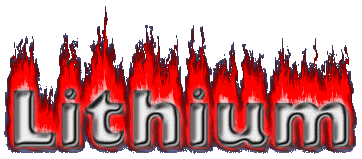
Basic Facts!
Physical Properties Lithium has atomic number 3 and and atomic mass of 6.941. Its melting point is 453.54K and its boiling point is 1,597K. It is a soft, silvery-white metal that reacts with water and burns in air with a white flame. It is the least dense metal, as a mater of fact, when it is solid (at 298 K) it is only about half as dense as water.
History: Lithium was discovered in 1817 by Johann Arvedson in Sweden. It's name comes from the Greek word "Lithos" meaning stone.
Uses: Lithium, in it's salt form, is most commonly used to treat Bipolar Disorder. It is used in light weight batteries such as the ones used in a pacemaker. The 200-inch telescope at Mt. Palomar contains lithium as a major ingredient. On a hot day you should be thankful for lithium because it is used in the air conditioning unit that is cooling you down. Lithium is added in small amounts to magnesium, aluminum, or lead-base alloys; it is also used as a degasifier in iron, steel, and copper refining. In addition, lithium is used to scavenge small amounts of oxygen and nitrogen in electronic vacuum tubes. Trace amounts of lithium and its compounds color a flame bright red; they are used in pyrotechnics.
Source: Lithium is widely distributed in nature; it is found in the soil, in plants, in animals, and in the human body. It is also found in the sun. Lithium may be profitably extracted from ores containing as little as 1% lithium (measured as lithium oxide). Some commercially important minerals are lepidolite, petalite, spodumene, and amblygonite
Compounds: . Lithium forms many inorganic compounds, among them a hydride (LiH), a nitride (Li3N), an oxide (lithia, Li2O), a hydroxide (LiOH), a carbide (Li2C2), a carbonate (Li2CO3), and a phosphate (Li3PO4). When heated it reacts directly with the halogens to form halides. Lithium aluminum hydride (LiAlH4) is an important reagent in organic chemistry. Lithium also forms numerous organic compounds. One compound of major importance is lithium stearate, produced by cooking tallow (or other animal fat) with lithium hydroxide; lithium stearate is used to transform oil into lithium-base lubricating greases, which have found extensive use in the automotive industry. Lithium carbonate is used in special glasses and ceramic glazes. Lithium chloride and bromide are used as brazing and welding fluxes; they are also used in air conditioning systems because they are very hygroscopic, i.e., they absorb moisture. Lithium hydroxide is used to increase the capacity of alkaline storage cells. Lithium compounds are used in the nuclear energy industry, in the preparation of plastics and synthetic rubber, and in the synthesis of vitamin A


 عکس عناصر (طنز)
عکس عناصر (طنز)